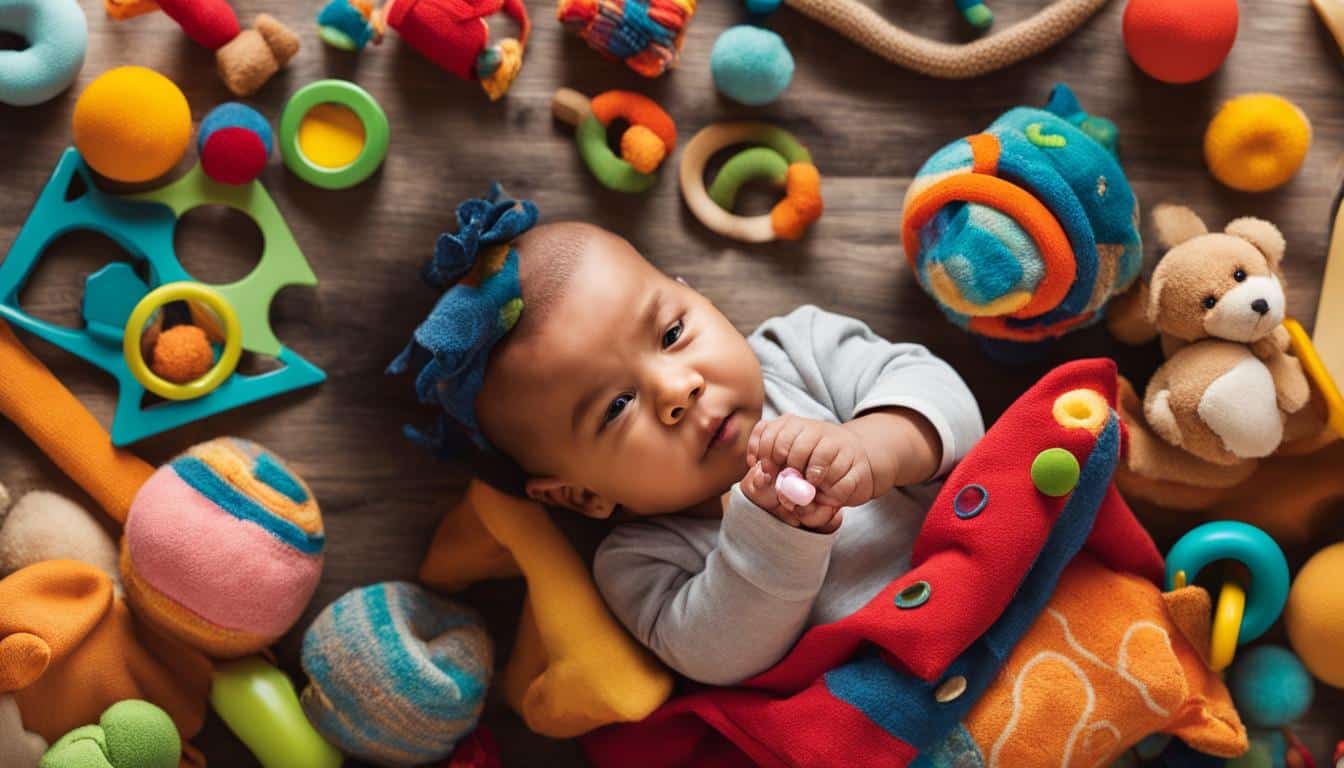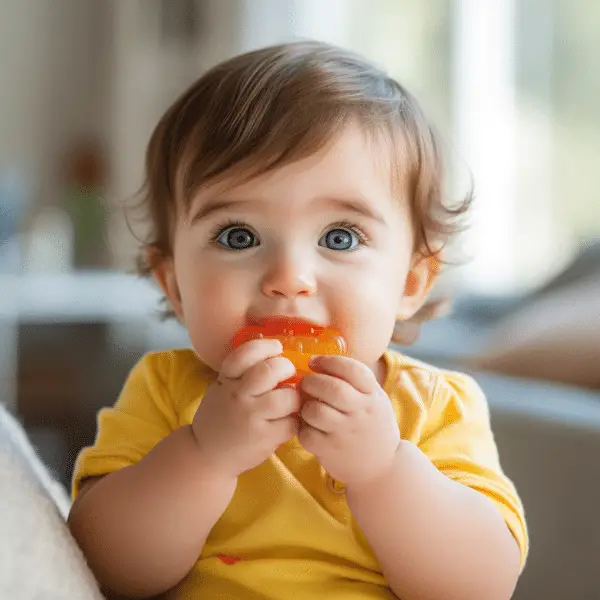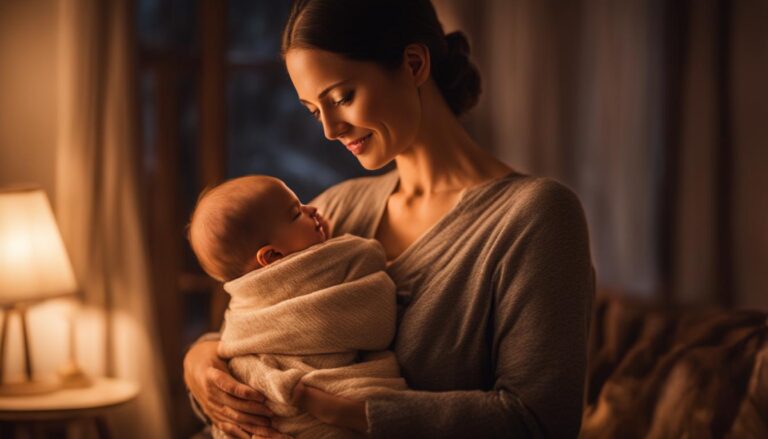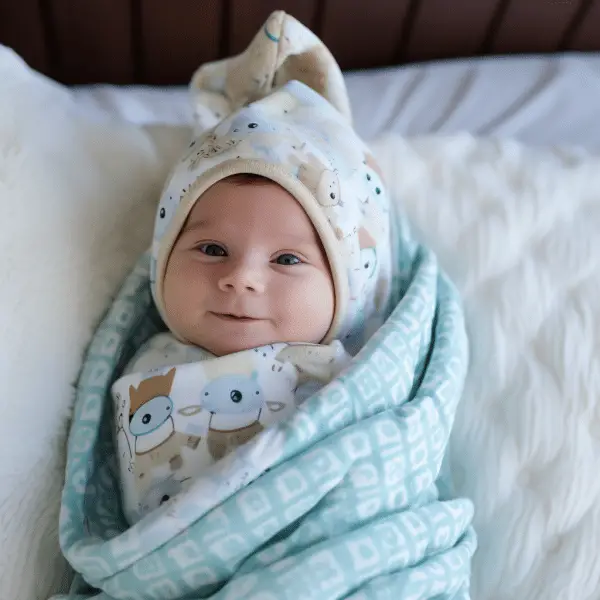The World Through Baby’s Eyes: Understanding Development
As parents, it is crucial for us to understand our baby’s development, especially when it comes to their vision. Babies go through a remarkable journey of learning to see and understand the world around them. From developing the ability to focus their eyes to learning how to process visual information, every milestone in their visual development is important.
Understanding baby development helps us track their progress and detect potential eye and vision problems that could cause developmental delays. Regular eye exams starting at around 6 months of age are recommended to ensure their visual health. Additionally, the InfantSEE program offers free eye assessments for infants between 6 and 12 months.
In this article, we will explore the different stages of baby development and how their vision evolves over time. By gaining a deeper understanding of infant vision development, we can actively support our baby’s growth and provide a solid foundation for their future learning and cognitive development.
Key Takeaways:
- Understanding baby development and visual milestones is crucial for parents.
- Regular eye exams starting at 6 months of age help detect potential eye and vision problems.
- The InfantSEE program offers free eye assessments for infants between 6 and 12 months.
- Baby’s vision evolves over time, from learning to focus their eyes to processing visual information.
- Tracking a baby’s visual milestones helps parents monitor their progress and detect delays or issues.
From Birth to 4 Months: Exploring the Visual World
During the first four months of their lives, newborns embark on an exciting journey of visual exploration. While their vision is still developing, they have the ability to see high-contrast targets and objects that are approximately 8 to 10 inches away from their face. This newborn vision allows them to focus on their caregivers’ faces during feeding and bonding moments, creating a strong parent-child connection.
Visual stimulation plays a crucial role in promoting eye development and eye-hand coordination. Parents can engage their infants by using toys with bold patterns or contrasting colors. Hanging mobiles or crib gyms with visually stimulating elements can also capture their attention and encourage them to track moving objects with their eyes. This early exposure to visual stimuli lays the foundation for further visual development.
“The first few months of a baby’s life are a critical time for them to learn about their environment through their eyes. By providing them with visually engaging experiences, we can support their visual development and set the stage for future learning and cognitive growth.” – Dr. Emily Thompson, Pediatric Optometrist
Although it is normal for a baby’s eyes to appear to wander or be crossed during this period, parents should still keep an eye out for signs of potential eye and vision problems. Constant eye turning or other signs of misalignment should be brought to the attention of a doctor of optometry. By being proactive in monitoring their baby’s visual development and seeking professional guidance when needed, parents can ensure that their little ones are on the right track for healthy vision.
| Age | Visual Milestones |
|---|---|
| Birth | Ability to see high-contrast targets and objects within 8 to 10 inches |
| 2 months | Tracking moving objects with their eyes |
| 4 months | Following moving objects with their eyes and reaching for things |
As babies continue to explore the world through their developing vision, it is essential for parents to provide them with a visually stimulating environment and seek regular eye assessments to ensure proper visual development.
Age 5 to 8 Months: Improving Control and Depth Perception
During the age of 5 to 8 months, babies continue to improve their control over eye movements and develop better eye-body coordination. They begin to acquire the ability to perceive depth, allowing them to understand and judge distances in three dimensions. By this stage, infants also develop good color vision, enabling them to distinguish various hues and shades.
It is important to note that crawling plays a significant role in further enhancing eye-hand-foot-body coordination during this period. As babies explore their surroundings by crawling, they engage various motor skills that contribute to their visual development. This stage is a crucial milestone in their overall growth and the refinement of their depth perception abilities.
To promote optimal visual development during this age range, it is beneficial for parents to engage their babies in age-appropriate activities that stimulate eye movement and coordination. Providing colorful toys and objects that encourage reaching and grasping can support the refinement of their depth perception and enhance their color vision. Additionally, creating a safe and stimulating environment that encourages crawling can further foster their eye-hand-foot-body coordination, contributing to their overall development.
Age 5 to 8 Months: Improving Control and Depth Perception
| Development Milestone | Description |
|---|---|
| Improved Eye Movement | Babies show better control over eye movements, enabling them to track moving objects more accurately. |
| Enhanced Eye-Body Coordination | Infants begin to develop better coordination between their eye movements and overall body movements, such as reaching for objects while looking at them. |
| Depth Perception | Babies start perceiving depth, allowing them to judge distances and understand the three-dimensional nature of their surroundings. |
| Color Vision | Infants acquire good color vision, enabling them to differentiate between various colors and shades. |
| Crawling | Crawling at around 8 months aids in the further development of eye-hand-foot-body coordination, contributing to overall visual and motor skill advancement. |
Age 9 to 12 Months: Standing, Grasping, and Judging Distances
During the period of 9 to 12 months, babies continue to make significant strides in their visual development. With increased physical abilities, such as standing and grasping objects, their visual memory starts to develop, allowing them to recognize familiar objects and pictures. Additionally, babies at this stage begin to judge distances fairly well, which enhances their spatial awareness and depth perception. This newfound ability enables them to throw objects with more precision than before.
At around 9 months, babies start to pull themselves up to a standing position, using furniture or other support. As they gain more control over their bodies, their hand-eye coordination improves, and they become capable of grasping objects with their thumb and forefinger, known as the pincer grasp. This fine motor skill development not only supports their visual development but also opens up new avenues for exploration and play.
Crawling also plays a crucial role in promoting better eye-hand coordination during this stage. As babies move around on all fours, they engage multiple senses simultaneously, which enhances their overall sensory and motor development. It is through crawling that babies are able to actively explore their surroundings, further refining their visual perception and judgment of distances. By crawling, they gain valuable experiences that shape their understanding of the world around them.
Table: Milestones in Visual Development (Age 9 to 12 Months)
| Developmental Milestones | Key Aspects |
|---|---|
| Standing | Babies start pulling themselves up to a standing position using furniture or other support. |
| Grasping | They develop the ability to grasp objects with their thumb and forefinger, known as the pincer grasp. |
| Visual Memory | Babies begin to recognize familiar objects and pictures, forming visual memories. |
| Distance Judgment | With improved depth perception, babies can judge distances fairly well and throw objects with more precision. |
As babies approach their first birthday, their visual memory continues to strengthen. They become more adept at recognizing familiar objects and pictures, demonstrating their growing ability to recall visual information. This development in visual memory paves the way for future learning and cognitive skills.
It is important for parents to encourage their baby’s visual development during this stage. Providing age-appropriate toys and objects that stimulate their vision and hand-eye coordination can further enhance their progress. Engaging in interactive activities, such as rolling a ball back and forth or playing with building blocks of different shapes and sizes, can also foster their visual and cognitive skills. By nurturing their visual engagement and providing them with a stimulating environment, parents play a vital role in supporting their baby’s development.
Age 1 to 2 Years: Well-Developed Eye-Hand Coordination
During the period of 1 to 2 years, children experience significant development in their eye-hand coordination, which enhances their fine motor skills and prepares them for future learning activities. At this stage, children are highly interested in exploring their environment and show a strong desire to look and listen, allowing them to engage with the world in a more interactive way.
Children in this age range can recognize familiar objects and pictures, leading to increased visualizing abilities. They can also scribble with crayons or pencils and engage in imaginative play, which further refines their eye-hand coordination. Providing opportunities for reading or telling stories can stimulate their ability to visualize, paving the way for the development of essential reading skills.
Parental involvement and encouragement play a crucial role in supporting the well-developed eye-hand coordination of children between 1 and 2 years of age. By providing appropriate activities and creating a nurturing environment, parents can foster their child’s visual development and lay a solid foundation for future cognitive growth.
Table: Age 1 to 2 Years: Activities to Enhance Eye-Hand Coordination
| Activity | Description |
|---|---|
| Rolling a ball back and forth | Encourage your child to engage in a game of rolling a ball with you, which helps develop eye-hand coordination and tracking skills. |
| Providing building blocks and balls of different shapes and sizes | Offer a variety of building blocks and balls to promote dexterity and precise manipulation of objects, enhancing fine motor skills. |
| Reading or telling stories | Engage in reading or storytelling sessions that involve visual imagery, allowing your child to practice visualizing and develop reading skills. |
Supporting Fine Motor Skills and Visual Engagement
In addition to activities that enhance eye-hand coordination, it is crucial to promote fine motor skills and visual engagement in children between 1 and 2 years of age. Providing age-appropriate toys and creating an environment that encourages exploration can contribute to their overall development.
- Offer toys that require the use of fingers and hands, such as puzzles and stacking blocks, to enhance fine motor skills.
- Engage in play that involves objects of different textures, weights, and colors, stimulating visual engagement and sensory perception.
- Encourage the exploration of the physical world through supervised play, allowing children to interact with various objects and develop their understanding of cause and effect.
By actively participating in age-appropriate activities and nurturing visual engagement, parents can play a vital role in fostering their child’s eye-hand coordination, fine motor skills, visualizing abilities, and future reading skills. This stage of development sets the foundation for further cognitive growth and prepares children for a lifetime of learning.
Signs of Eye and Vision Problems in Infants
Eye and vision problems may be rare in infants, but it’s important for parents to be vigilant and aware of potential signs. Early detection and intervention can prevent potential developmental delays and ensure the well-being of your baby’s visual health. Here are some common signs of eye and vision problems to watch out for:
- Excessive Tearing: If you notice that your baby’s eyes are constantly watery or tearful, it could be a sign of blocked tear ducts. Blocked tear ducts are common in newborns and usually resolve on their own within the first year of life. However, if the tearing persists or is accompanied by other symptoms, it’s important to consult a doctor.
- Red or Encrusted Eyelids: Redness or crusting around the eyelids may indicate an eye infection. Bacterial or viral eye infections can cause symptoms such as redness, discharge, and swelling. If you notice any of these symptoms, it’s essential to seek medical attention to prevent further complications.
- Constant Eye Turning: If your baby’s eyes consistently turn inward or outward, it could be a sign of eye muscle control issues. This condition, known as strabismus, can affect binocular vision and depth perception if left untreated. Consulting an eye care professional will help determine the appropriate course of action.
- Extreme Sensitivity to Light: If your baby becomes overly sensitive to light or consistently squints in bright environments, it may indicate elevated eye pressure. Increased intraocular pressure can be associated with conditions such as glaucoma. Prompt medical attention is necessary to prevent potential vision loss.
- White Pupil: The appearance of a white pupil in flash photographs or under certain lighting conditions may be a sign of eye cancer, such as retinoblastoma. This rare but potentially serious condition requires immediate evaluation by a healthcare professional.
If you notice any of these signs or have concerns about your baby’s eye and vision health, consult a doctor of optometry who specializes in pediatric eye care. Early intervention and regular eye exams can ensure your baby’s visual development remains on track and address any potential issues proactively. Remember, vigilance and timely action are key to maintaining healthy eyes and optimal visual function in infancy and beyond.
| Sign | Possible Cause |
|---|---|
| Excessive Tearing | Blocked tear ducts |
| Red or Encrusted Eyelids | Eye infection |
| Constant Eye Turning | Eye muscle control issues (strabismus) |
| Extreme Sensitivity to Light | Elevated eye pressure (glaucoma) |
| White Pupil | Eye cancer (retinoblastoma) |
Helping with Visual Development: Age-Appropriate Activities
To support your baby’s visual development, it’s important to engage them in age-appropriate activities. From newborns to 4 months old, using a nightlight or dim lamp in the baby’s room can provide gentle visual stimulation. Additionally, changing the position of their crib and keeping reach-and-touch toys within their focus range can help them explore the visual world around them.
As your baby grows from 5 to 8 months, hanging mobiles or crib gyms can capture their attention and encourage their visual tracking skills. Providing playtime on the floor with colorful toys and objects will further stimulate their visual development. It’s also beneficial to offer them toys that can be held in their hands, allowing them to practice their eye-hand coordination.
Between 9 and 12 months, activities that promote crawling and creeping are crucial for developing eye-hand coordination. You can also engage your baby by naming objects while talking to them, as this helps them associate words with visual stimuli. Playing hide-and-seek games can be exciting for them and support their visual development.
From 1 to 2 years of age, activities that involve rolling a ball back and forth can enhance your child’s eye-hand coordination. Providing building blocks and balls of different shapes and sizes allows them to explore spatial awareness and improve their visual perception. Reading or telling stories with colorful pictures stimulates their imagination and further enhances their visual development.
The Importance of Eye Contact and Gaze Following
Eye contact and gaze following play a crucial role in infants’ social interactions, language development, and emotional understanding. Research has shown that infants are highly attuned to eye contact and are more likely to look at an object when a person turns towards it with open eyes. Additionally, infants gaze longer at objects when adults look at them with open eyes. These behaviors reflect infants’ innate sensitivity to social cues and the importance of visual engagement in their interactions with others.
By 14 months of age, infants become sensitive to things that may obstruct another person’s view, such as headbands or blindfolds. This understanding demonstrates their developing ability to perceive the world from another person’s perspective. Gaze following and joint attention, which refers to the ability to share attention with another person, are crucial for language development and understanding the emotions of others. Through eye contact and gaze following, infants establish connections with caregivers and learn to interpret non-verbal cues, paving the way for meaningful communication.
The role of eye contact and gaze following extends beyond social interactions. These abilities also contribute to infants’ cognitive development and understanding of the physical world. By paying attention to others’ eyes, infants gain valuable information about objects and their properties. They learn to make predictions about whether objects are safe, desirable, or distasteful based on the cues they receive from others’ eyes. Eyes serve as powerful social cues, guiding infants’ perceptual experiences and influencing their responses to the world around them.
The Role of Eye Contact and Gaze Following in Joint Attention
Joint attention is the coordinated attention between two individuals towards an object or event. Eye contact and gaze following are fundamental components of joint attention. When infants and caregivers establish joint attention, they engage in shared experiences and create connections that enhance their social and cognitive development. Joint attention facilitates language development as infants learn to follow the caregiver’s gaze and associate words with objects or events in the environment. It also enables infants to understand the emotions of others, as they learn to interpret facial expressions and gaze direction.
| Benefits of Eye Contact and Gaze Following | Examples |
|---|---|
| Promotes social bonding | “When an infant and caregiver establish eye contact, they form a connection that strengthens their relationship.” |
| Aids in language development | “Following the caregiver’s gaze helps infants associate words with objects or events, enhancing their vocabulary.” |
| Enhances emotional understanding | “Infants learn to interpret facial expressions and gaze direction, allowing them to understand the emotions of others.” |
In conclusion, eye contact and gaze following are vital aspects of infants’ development, impacting their social interactions, language acquisition, and emotional understanding. By actively fostering eye contact and engaging in joint attention, caregivers can support their infants’ growth and lay the foundation for future learning and cognitive development.
Understanding the Development of Gaze Following
Gaze following, a crucial aspect of perceptual development, allows infants to detect and interpret the direction of another person’s glance. While infants demonstrate early signs of gaze following at around 12 months, their abilities become more sophisticated by 14 months. By this age, infants can distinguish whether another person’s eyes are open or closed, and they begin to understand that obstructed views may limit their partner’s perception. This deeper level of understanding is essential for the development of joint attention and the ability to perceive the world from another person’s perspective.
The development of gaze following is closely related to head movements, as infants often orient their heads towards the direction of a perceived gaze. They begin to comprehend the significance of eye contact and recognize its role in social interactions. Infants become sensitive to when another person’s view may be impeded, such as when wearing a headband or blindfold, indicating their emerging understanding of others’ perspective.
Joint attention, which involves coordinating attention with others, is intrinsically tied to gaze following. As infants gain the ability to follow another person’s gaze, they become more adept at engaging in joint attention experiences. This skill plays a fundamental role in language development and the understanding of emotions in others. By following the direction of someone’s gaze, infants can share attention and focus on the same object or event, facilitating communication and social connection.
| Gaze Following Milestones | Age |
|---|---|
| Basic gaze following begins | 12 months |
| Ability to distinguish between open and closed eyes | 14 months |
| Understanding of obstructed views | 14 months |
| Emerging joint attention skills | 14 months |
In conclusion, the development of gaze following is a crucial aspect of perceptual and social development in infants. As they grow, infants begin to comprehend the significance of eye contact and the direction of others’ gazes. This understanding allows for joint attention experiences and fosters language development and emotional understanding. By appreciating the development of gaze following, parents and caregivers can support their infants’ perceptual and social growth.
The Role of Eyes in Learning and Understanding the World
When it comes to a baby’s development, the eyes play a vital role in helping them learn and understand the world around them. Through visual engagement, infants can gather important information about objects, people, and their environment. By paying attention to others’ eyes, babies can make predictions about the physical properties of objects and whether they are safe, desirable, or distasteful. Eyes serve as social cues, providing valuable insights into others’ perceptual experiences. Infants are highly sensitive to social partners and recognize the importance of visual engagement for interacting and responding appropriately.
To emphasize the significance of eyes in learning, consider this quote from Dr. Lea Gottesman, a pediatric ophthalmologist: “Babies are born with the innate ability to focus on human faces and are particularly drawn to the eyes. They learn from visual cues and the reactions of those around them, leading to important discoveries about themselves and the world. It’s through these visual interactions that infants begin to understand others’ perspectives and develop empathy.”
Understanding the physical world is a crucial aspect of a baby’s perceptual experience. By observing objects and people around them, infants start to comprehend how things work and their place in the world. Visual engagement not only supports cognitive development but also lays the foundation for language acquisition and emotional understanding. By actively participating in age-appropriate activities and nurturing visual engagement, parents can provide their babies with the tools to navigate and thrive in the world.
| Role of Eyes in Learning and Understanding the World | Key Points |
|---|---|
| Eyes serve as social cues | Provide valuable insights into others’ perceptual experiences |
| Visual engagement | Allows babies to make predictions about objects and their properties |
| Observing the physical world | Helps infants understand how things work and their place in the world |
| Nurturing visual engagement | Lays the foundation for language acquisition and emotional understanding |
Conclusion
Understanding baby development and the importance of visual development is crucial for parents. By knowing the milestones and recognizing potential signs of eye and vision problems, parents can actively support their baby’s growth and well-being. From birth to 4 months, babies begin exploring the visual world, developing eye-hand coordination and tracking moving objects. As they reach 5 to 8 months, their control and depth perception improve, allowing them to judge distances and develop color vision.
Between 9 to 12 months, babies start standing, grasping objects, and judging distances. Their visual memory develops, and they can recognize familiar objects and pictures. By 1 to 2 years, a child’s eye-hand coordination should be well developed, and they become more interested in exploring their environment. Activities like reading or telling stories stimulate their ability to visualize, setting the foundation for learning and reading skills.
Parents can play an active role in their baby’s visual development by engaging in age-appropriate activities. From using nightlights and providing reach-and-touch toys for newborns to encouraging crawling and creeping for older infants, there are various ways to enhance visual development. Eye contact and gaze following also play significant roles in language development and understanding the emotions of others. By nurturing visual engagement and providing a solid foundation, parents can support their baby’s future learning and cognitive development.
FAQ
When should I start having regular eye exams for my baby?
Regular eye exams for babies should start around 6 months of age.
Is there a program that offers free eye assessments for infants?
Yes, the InfantSEE program offers free eye assessments for infants between 6 and 12 months.
What are the milestones in infant vision development?
The milestones in infant vision development include the ability to focus their eyes, move them accurately, use them together, process visual information, and understand the world around them.
When do babies start developing eye-hand coordination?
Babies start developing eye-hand coordination from birth, but it continues to improve over time.
What are the signs of eye and vision problems in infants?
Signs of eye and vision problems in infants include excessive tearing, red or encrusted eyelids, constant eye turning, extreme sensitivity to light, and the appearance of a white pupil.
How can I help with my baby’s visual development?
For newborns to 4 months, using a nightlight or dim lamp, changing crib positions, and keeping reach-and-touch toys within their focus can be beneficial. From 5 to 8 months, hanging mobiles or crib gyms, providing playtime on the floor, and offering toys that can be held in the hands aid visual development. From 9 to 12 months, encouraging crawling and creeping, naming objects while talking, and playing hide-and-seek games can support visual development. From 1 to 2 years, activities like rolling a ball back and forth, providing building blocks and balls of different shapes and sizes, and reading or telling stories can further enhance visual development.
What is the role of eye contact and gaze following in development?
Eye contact and gaze following play crucial roles in language development and understanding the emotions and perspectives of others.
When do infants start showing evidence of gaze following?
Infants start showing evidence of gaze following from as early as 12 months, but it becomes more sophisticated by 14 months.
How do babies perceive the world through their eyes?
Babies perceive the world through their eyes by paying attention to others’ eyes, which provide valuable social cues and information about the physical world.
Why is understanding baby development important?
Understanding baby development, specifically in terms of vision, is important for parents to ensure their child’s growth, well-being, and future learning and cognitive development.






